Democratizing AI Futures Deliberative Workshops
1 Online deliberation results
(AI Objectives Institute participates in this event and uses the open data from this event to produce a visual interactive report.)
2 On-site deliberation results
2.1 Evaluation results
- (I) There are essentially 3 concerns to focus on regarding AI's impacts on society:
- 1. Labor force released and redefined: Whether the labor force released by technological advancements is returned to workers or employers will be critical to the work transformation that future generations of workers will face.
- 2. Information identification and industrial application: Due to the rapid changes in AI generation technology, correctly identifying the information provided by AI has become the most important issue in the future, particularly for industries that use AI to improve work efficiency. However, how to prevent the impact of false information provided by AI is even more critical.
- 3. AI assistance may have cognitive and creative limitations: As AI applications become more prevalent, a critical issue in future society will be to ensure development while preserving human connectivity and well-being.
- (II) Complementary approaches to public governance and citizen participation:
- 1. It is advised to hold regular public hearings to consult with the private sector and gather information regarding manufacturers' and users' needs, concerns and opinions. The private sector can raise issues to help facilitate systemic implementations by the government.
- 2. It is recommended the government organize workshops and interact with the people. Similar to this deliberative workshop, the goal is to gather more feedback from everyone and consider what needs will arise for Taiwan local once AI development has been implemented.
- 3. It is recommended that the government should provide information to private sector through administrative guidance or show users how to trace the sources. What can be done in terms of traceability, what are the possible directions and what are the potential negative consequences?
- 4. Manufacturers can also establish private response platforms to collect feedback. To a certain extent, this can also become a mechanism for manufacturers to collaborate with one another.
- 5. Finally, we encourage manufacturers across industries to form internal self-review committees for AI or organize tools akin to fact-checking teams. This type of private supervision energy can be established, and building such a community can also facilitate education and empowerment.
- (III) Integrate AI into future co-creation plans:
- 1. Data openness and control boundaries: Most groups believe traceability is necessary and must be clearly defined, while a few feel it is unnecessary. Some hope that de-personalization, exit mechanisms and other more stringent standards for controlling boundaries should be added during the transformation process. Through this multi-level management, we can encourage public data diversification and inspire the people to use more open data.
- 2. Standard process and competition-related matters: Most groups believe that collaborative mechanisms such as citizen participation should be established to fulfill the government's goals while achieving education and empowerment. For example, most groups are willing to organize public participation activities such as competitions to promote discussions. As for whether competition events should be divided into AI and non-AI groups, most of those present believe there is no need to make such a distinction. However, the production records, processes or the proportion of AI used must be clearly defined. Of course, few groups believe such distinction is still necessary, and they should further inspect whether there are any relevant specifications for the technology.
- 3. Counseling mechanism and expanded application: Most groups believe AI can be used as a judge or coach, particularly in coaching. But decision-making must still include a proportion of human decisions. AI can be used to popularize education and expand its applications. Meanwhile, consideration must be given to avoiding the impact of digital and knowledge gaps.
- (I) There are essentially 3 concerns to focus on regarding the impact of AI on society:
- 1. At the individual level, assessing data accuracy across multiple sources is a critical skill for the next generation.
- 2. Most groups believe industrial upgrading is critical at the stakeholder community and social impact levels. The key to future competitiveness is enhancing individual workers and the overall industry.
- 3. At the national level, most groups believe that the country should use AI regulatory policies to institutionalize a system that can be employed in various fields to drive and promote industrial upgrading and respond to social needs.
- (II) Complementary approaches to public governance and citizen participation:
- 1. Data openness and supervision: This session made a rather particular recommendation about whether the government should conduct more in-depth oversight. The private sector should be encouraged to provide databases for the government to build records. All parties look forward to including the United Nations indicator specifications in domestic legislation similar to the Digital Intermediary Act.
- 2. Verification and traceability: It is strongly advised to compulsorily mark the finished product's identification code or provide a seed code. If AI is used, provide a mark to inform everyone that the work was generated using AI. Another method is for the government to use this control tool for verification or for the community to collaborate and build a verification network.
- 3. Educational counseling and AI literacy courses: This is the top-down, bottom-up part anticipated by everyone. The other part is to improve information literacy and credibility. Everyone believes that we can respond and improve quality by popularizing education or promoting education literacy.
- (III) Integrate AI into future co-creation Plans:
- 1. Use AI to identify AI: The key to discussing identification capabilities is that using AI or related classifications will be meaningless if we cannot identify the products. However, creating classification standards will also help inform the people about the various levels of AI applications. Secondly, these classification standards can also be used as a basis for comparison.
- 2. Data openness and unified standards: The unified format code component can also be linked to the need to increase application popularity, AI literacy education and other areas. From the social events standpoint, we hope to propose regulations and conduct crime audits and information security protection. We should begin by considering the people's demands and then determine how to implement prevention while establishing norms and standards.
- 3. Standard process and competition matters: Determioning what the objective is in terms of standard and competition is critical. It determines whether the competition is based on technology, humanistic traits or human-machine balance. It is necessary to differentiate if AI, no AI or a proportional system such as human and AI collaborative creations is used. A proportional distinction should also be made to classify the competition categories. Some groups were classified as singing groups or model groups based on particular criteria, and all of these criteria should be further clarified and determined.
- 4. Interdisciplinary innovation collaboration projects: Everyone believes that starting with the private sector and assisting the public sector in establishing an AI co-creation platform structure could be a solution, and we hope the government can encourage and promote such projects.
- 5. Counseling mechanisms and expanded applications: Provide counseling on AI product development, which will be fed back to industry and public systems for applications. We should aim for a balanced development of technology and humanities while also preserving traditional humanistic values rather than solely focusing on AI development and ignoring the original, traditional or universal humanistic social values.
2.2 Comprehensive results discussion
We initiated two rounds of citizen participation discussions, collected extensive opinions and held specific policy debates to address the impacts of AI on society. Citizen participation can serve as a model for public-private collaboration. Individuals and stakeholder groups closely related to the issues participating in the discussions represent the people and reflect professional opinions from all segments of society. They are sufficient to serve as the legitimate foundation and primary reference for national governance. The following points are supplemented with illustrations:
- (I) Individual level: labor force release and empowerment Individuals believe AI will significantly impact working conditions and rhythm, regardless of occupation, industry category or professional field. It is necessary to consider whether the dividends of labor force release are returned to workers or employers. On an individual level, it is essential to continuously train individuals to acquire basic operational and information recognition skills. This will enable them to cope with future work demands or life transformations. Active empowerment relies on individuals' professional capabilities within the community, as well as educational training and a variety of citizen participation opportunities. In this manner, the people's abilities can potentially improve and contribute to social needs.
- (II) Stakeholder community level: industrial upgrading and transformation counseling For the stakeholder communities closely related to this issue, AI is believed to upgrade core products, such as the information and communication technology (ICT) industry, while promoting industrial and social transformation. Some industries, such as design, translation and graphics, rely on counseling to improve organizational capabilities. Most participants mentioned that law, education, imaging and other fields may be significantly impacted. Under the AI wave, the competitiveness of industries will depend on whether workers entering the labor force possess the necessary digital skills, or if there are training mechanisms at the national and community level. Participants also proposed and affirmed the importance of increased collaboration between the public and private sectors, and the use of community support to provide oversight as well as checks and balances.
- (III) National level: institutionalization of regulatory policies Most people believe regulations must be clear at the national governance level so that innovation, research and development can advance in accordance with the law. That is, state regulation must shape the system so that those subject to regulation or related industries and the people can understand boundaries and have the right to express opinions on regulatory boundary formation. Therefore, if the national governance tool design is more transparent, it will benefit individuals, stakeholder communities and even the overall positive cycle of society.
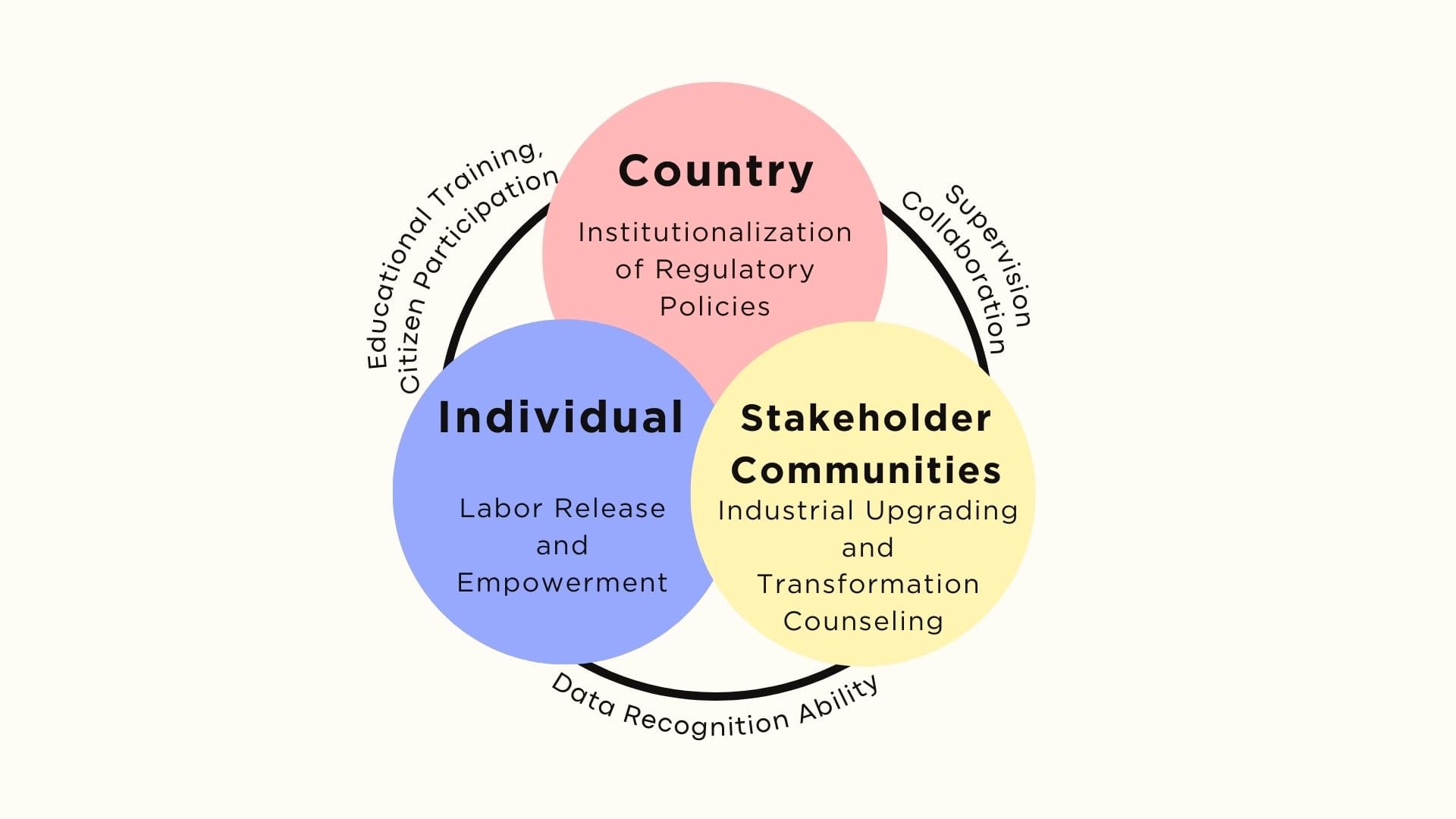
2.3 Potential cooperation methods
The two Democratizing AI Futures Deliberative Workshops were initiated from the concept of Ideathon to launch the Democratizing AI Futures dialogue. As a result, most participants in this event are the target audience for Ideathon activities. The discussion content has gradually shifted away from the impact of AI on various aspects of society and toward policy tools, such as public governance, citizen participation, and data collection methods. Through the review and discussion design, as well as the guidance and leadership of the facilitators, we now have a better understanding of how the social impact of AI is being fermented in Taiwan society.
Please refer to the list of invited participants for future suggestions. Those with more practical insights or implementation experience on the social impact of AI can continue to follow up or arrange in-depth interviews regularly. These key figures may be able to raise awareness for the issues in respective fields, allowing the moda to connect the dots and continue to collect implementation status data from all walks of life. Focus discussions or workshops geared toward citizen participation can be held for specific occupations or industry categories as needed to strengthen the link between public and private sector cooperation, which enables sustainable implementation of Democratizing AI Futures in areas of need from policy planning down to the social demand response level.
2.4 Results report and related links
3 Summary
Center for Innovative Democracy and Sustainability (CIDS), National Chengchi University (NCCU) was commissioned by the moda's Department of Digital Strategy to hold two Democratizing AI Futures Deliberative Workshops. The Center comprises team members from the public sector, practice fields and academic circles dedicated to improving democratic participation procedures and social dialogue methods. The center's vision for social dialogue is to start with the issues and progress through various stages of communication and collaboration with social partners. Specifically, social partners with policy interests, such as citizen activists, organizational groups, experts and scholars, and government departments, engage in cross-field or cross-level dialogue via discussions, consultations and joint actions, to confront today's complex issues, build consensus and promote democratic participation.
CIDS members' creative thinking increases public participation channels in public policy. The center's recent research has focused on the governance of technological subjects, such as NIMBY technology facilities and human rights, social impact assessment on technological innovation, nuclear waste site selection and citizen participation. The goal is to bring public issues to the table to find the best solution for social development after integrating opinions from various forums.
Generative AI combines Big Data computing, real-time content production, and machine deep-learning technology to develop the ability to imitate and create. The application of AIGC has the potential to revolutionize modern society's labor structure, industrial layout and even daily habits, bringing significant impacts and opportunities to social operations. According to GitHub, the world's largest program code management platform, 92 percent of American program developers indicated they use generative AI to write programs at work, and 70 percent of interviewees believed that using AI can improve programming quality and work efficiency. In the past, however, most people in the art and creative industries regarded human intellectual property worthy of legal protection. Nowadays, combining generative AI with personal creativity can vastly increase efficiency and precision, but may also trigger debates on intellectual property ownership. Moreover, regarding the negative impact on society, if people's social biases and prejudices can be generated using generative AI and quickly spread through the communication system, discrimination will be accelerated to some extent, and ideological dissemination and social antagonism may escalate. These factors must be carefully considered as we develop and utilize generative AI.
Generative AI is rapidly evolving and becoming a competitive field among major technology industries. The development of generative AI has marked the beginning of a new era in society, and the international community has also begun to consider and propose related control plans. For example, the Organization for Economic Cooperation and Development (OECD) defines AI as "machine-based systems that can predict and provide suggestions or decisions to affect the physical or virtual environment to achieve human-set goals. This system has a certain degree of autonomy and is a machine capable of performing human-like cognitive functions." It also proposed the "OECD AI Principles," which include recommendations for national policies and international collaboration. These recommendations are as follows: (1) Invest in AI R&D; (2) Build an AI-friendly digital ecosystem; (3) Create an AI-friendly policy environment; (4) Cultivate human resources and prepare for labor market transformation; and (5) Implement international cooperation on trustworthy AI (OECD, 2023 17). The OECD research report also said that generative AI can filter large amounts of data and assist governments in making policy decisions. It can predict and help prevent election interference events and improve public services. The OECD agrees that generative AI should be used in government governance, but cautions that it may undermine democratic values by perpetuating and amplifying social inequality. Generative AI may further undermine trust and social contracts if not adequately regulated.
In the context of Taiwan, the impact of generative AI on society is evident as per the international trend, and AI's interactions with democracy, society and politics are also apparent. However, most current discussions in Taiwan continue to center on industrial development, such as evaluating the use of AI by the private sector to cut costs or create benefits for enterprises. Beyond the development and economic aspects, the impact of generative AI on democracy, society and politics should be critical questions for governance and long-term social development. Regarding academic research development, many studies have recently raised concerns about the various ethical threats that generative AI may pose to the public sector. Since different technological waves will result in other aspects of government transformation, they will also generate other public services and values. On the other hand, research directions that are policy-responsive, social demand-oriented, and focus on social entities or different industrial categories have resulted in more policy-responsive and socially demand-oriented research directions.
Accordingly, NCCU was commissioned by the moda's Department of Digital Strategy to collect data from netizens who are interested in discussing AI issues using the ministry's polis.tw public opinion survey report. The goal is to evaluate the more divergent ideas about specific generative AI issues among the people. Taiwan-specific issues can be addressed through such discussions, enabling policymakers to identify and mitigate potential risks in the future.
- (I) Definition of participant representativeness The Ideathon platform initiated the two Democratizing AI Futures Deliberative Workshop sessions and launched the Democratizing AI Futures dialogue concept. Most participants in this event have contributed to Ideathon activities and volunteered to attend the workshop. The remaining participants are experts and scholars who were invited to attend. The source of participants in this event is specific target groups solicited via the voluntary and invitation systems. Not all event participants are front-line users. It is also clear that the proportion of people working in the design field is significantly higher than that of other fields, and there is a gap in their understanding, ideas and performance in technology applications. The appropriate source, number and representativeness of participant invitations depend on the purpose of the event design because one of the topics to be discussed in these two sessions is revised and used as the submission method for the next Ideathon. The composition of the participants in this event is connected and aligned with the purpose of the discussion. The event's design attempts to set the agenda by focusing on the impacts of AI on society. Various professionals can provide perspectives to create a preliminary blueprint in this direction. If there are plans to hold future discussions on similar topics, it would be helpful to consider making more diverse designs that consider the participants' representativeness. This could involve discussions in separate groups, with an invitation-only system for some sessions and a voluntary participation system for others. Such an approach can assist the event organizer in achieving the event's purpose and reaching the necessary opinion sources.
- (II) Agenda setting for deliberative workshops The two Democratizing AI Futures Deliberative Workshop sessions started by collecting opinions from netizens. These opinions were summarized using polis.tw and supplemented with domestic and foreign news, research trends and other relevant information. The opinions were then categorized into six major themes (internal government governance applications, emerging law-supervision mechanism rule, information identification, data openness, intellectual property, education and human cognitive impacts) for on-site discussion. As the majority of participants in the Ideathon are volunteers, with some invited experts and scholars, the executive team assigns experts and scholars to groups based on discussion topics that align with professional fields. Since the voluntary contributors came from various backgrounds, they were randomly assigned to the topic groups. As a result, the opinions expressed in each group range from academic and practical to imaginative; the participants may not have a complete grasp of the assigned discussion topics. The practical operation of AI is limited by the technology's immaturity and lack of understanding among most people. As a result, many lack a comprehensive understanding or sufficient experience in dealing with the limitations and dilemmas of practical AI operations. The issues raised by AI applications are not about the knowledge or ability that can be manipulated through citizen consensus. It takes people with actual contact, training, or application experience to conduct a more in-depth analysis and propose prospective recommendations. If the opportunity to discuss similar topics arises in the future, we can prioritize the discussion topics, choose a singular topic or correspond to a specific occupation or industry category and conduct a more in-depth discussion. Only then can we gain a more accurate grasp of AI's practical applications or impacts on society.
- (III) Policy recommendation tracking and implementation Since citizen participation activities require significant pre-launch preparation and on-site communication, participants who are willing to spend time participating will likely have a certain degree of participation efficacy. There is a sense of efficacy or a certain expectation that the insight offered through discussions will be adopted. Even if the deliberation team has prior knowledge and on-site leadership, a good deliberation event can focus everyone's opinions on several meeting conclusions that most participants present are interested in and agree with. It may also be able to produce relevant policies through guidance. Even if the discussion during a meeting is engaging and effective in participation, the implementation of actual policy agendas and the impact of meeting conclusions on policies must still be executed by a civil service system with the appropriate powers and responsibilities. Common sense suggests that it is difficult for participants to continue tracking the subsequent policy implementation effects after similar discussion activities. Most policy development and promotion take time and are unlikely to be immediately enforceable, which has policy-oriented or social implications. The complex nature of such development issues makes it harder to confirm subsequent effects. Whether the outcomes of discussions held in event venues will have a tangible impact on policies, or if the content of the discussion aligns with the intended purpose is yet to be determined. Ultimately, this can only be tested through practical implementation. The results of these docking policies and practices are beyond the scope of what can be determined or guaranteed by current deliberation activities.
4 Methods
The two events drew a total of 95 participants. Regarding gender ratio, males had a slightly higher proportion than females, with the former accounting for 61.1 percent and latter 38.9 percent. Based on two independent analysis sessions conducted in Taipei and Tainan Cities, the male ratio remains higher than the female. Please refer to the figure below:
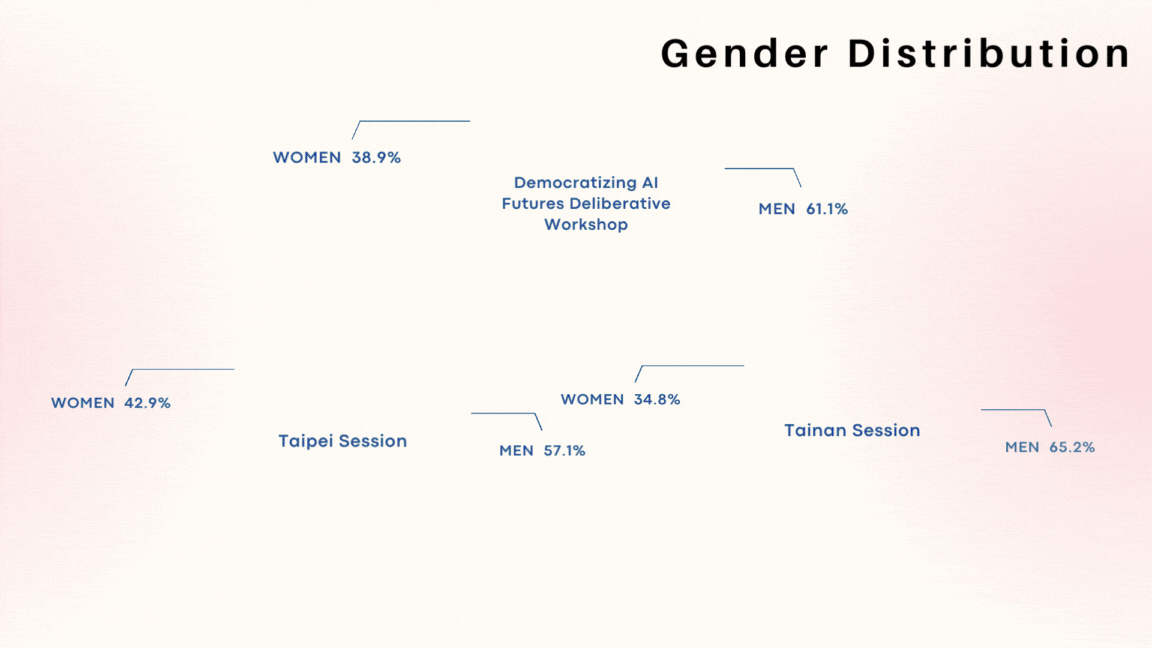
In terms of age distribution analysis, when the number of participants in both sessions is combined, the majority of participants are between the ages of 18 and 29 (about 40 percent), followed by those between the ages of 30-39 (24.7 percent), and those between the ages of 40 and 49 (22.4 percent). Participants under the age of 49 account for over 87 percent of the total. Most of the participants in this event are from the youth and young adult generations. Please refer to the figure below:
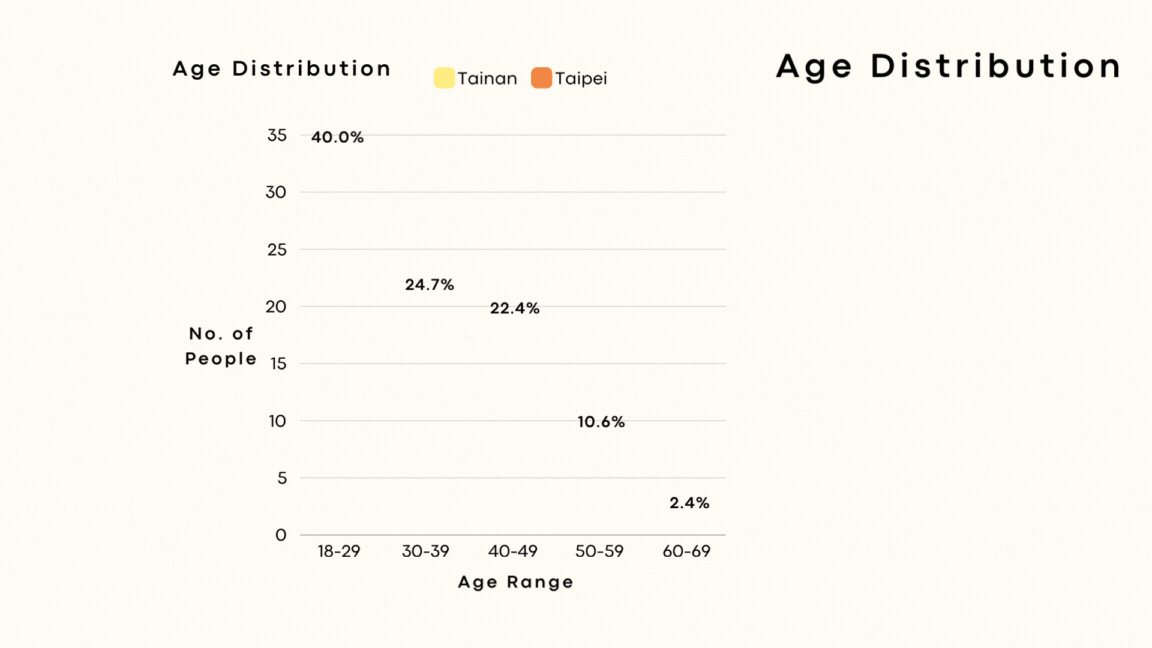
When we combine the number of participants from both sessions and analyze the types of units they belong to, we find that 41.9 percent of the participants are from schools or government think tanks, while 40.9 percent are from civil society groups or companies. The remainder belong to government units. Participants in this event are evenly divided between academic units, as well as the second and third sector. The first sector accounts for 17.2 percent of the total. Please refer to the figure below:
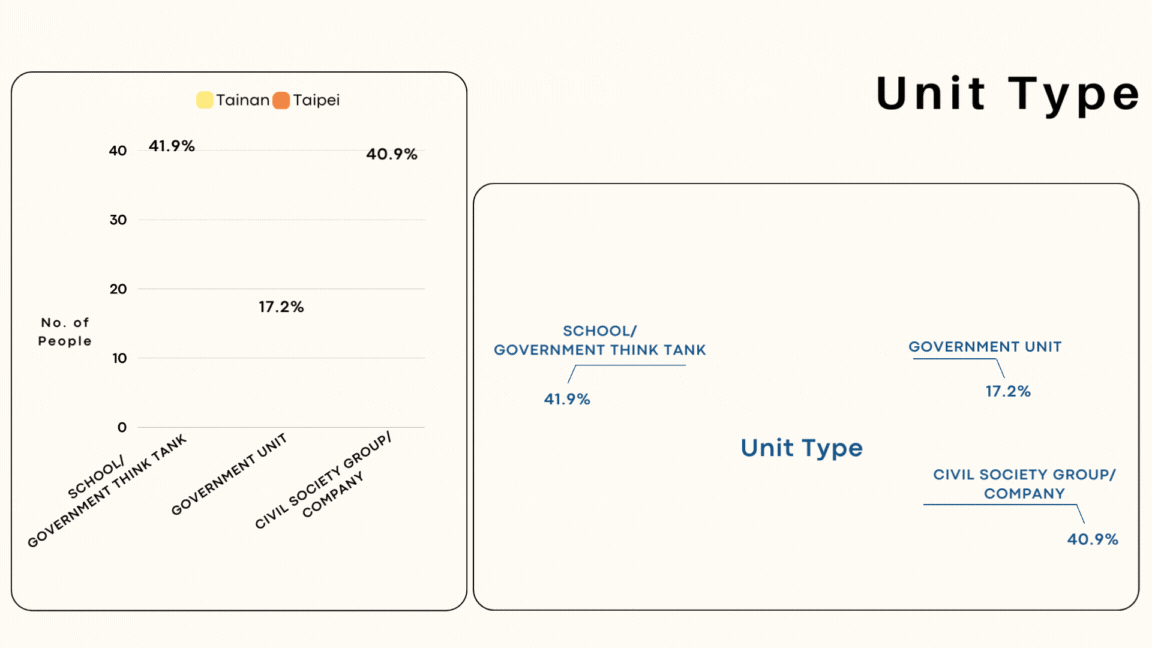
When the number of participants in both sessions is combined, an analysis of the participants' professional fields distribution indicated that over 60 percent come from the fields of digital technology and design, with the remainder coming from the social sciences, law, business, medicine/psychology and education fields. The professional fields are heavily concentrated in digital technology and design, likely related to the fact that this participant's invitation source is primarily associated with Ideathon contributors. Please refer to the figure below:
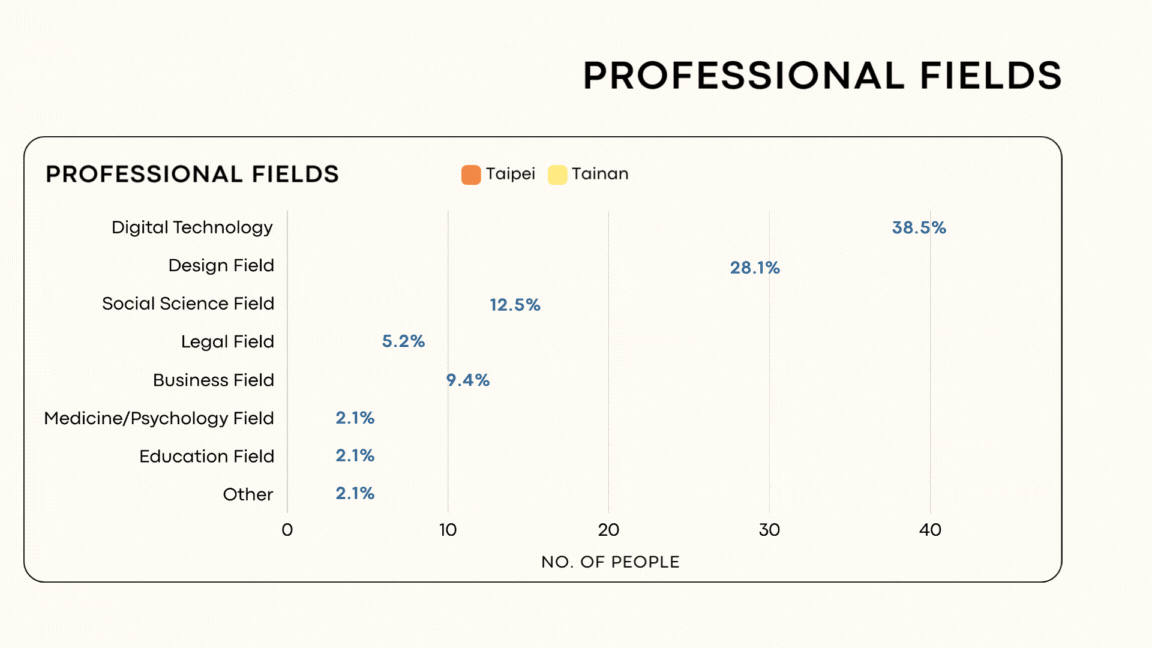
CIDS and NCCU advocate a social dialogue method that begins with analyzing the issues, inventorying the issue's current status on the network and identifying the challenges or problems that must be addressed. We then enter the stakeholder identification phase to consider who the stakeholders are and the purpose of each stakeholder's role in the context of this issue. Next, we can develop and customize operational methods based on practical needs during the issue diffusion phase through various levels of dialogue frameworks. The center's social dialogue design maintains deliberation and speculation, as well as emphasizes the importance of empathy and putting oneself in the shoes of others. We believe it is vital for every discussion to focus on theory and incorporate physical sensations in relating the issues to everyday life.
This workshop adopted the center's established methods to inventory and analyze the current state of generative AI issues. Additionally, opinions collected from polis.tw were examined to identify what the people think about the generative AI scenario. Finally, we investigated the causes of debates on various issues through the design and operation of the two deliberative workshop sessions, which can be used as a reference for future policy planning. The following is a brief description of the design concept and operation plan for this event:
- (I) Scenario setting
We employed action drama performances at the start of the sessions to help participants easily understand the objectives of the subsequent topic discussion. The scenario setting of the action drama is as follows:
How will the multiverse of generative AI change our current lifestyle?

"A" owns a consulting company that assists the private sector in developing generative AI services. Generative AI has advanced on a large scale over the years. In addition, generative AI development requires high professionalism. With abundant resources, "A's" capital has also increased significantly in the past few years. Recently, "A" helped company "B" to develop an image design robot. Employee "C" of company "B" is thrilled that generative AI can help to generate ideas, which has dramatically improved his work efficiency and eliminated the dark period of the past when he had to work overtime.
Employee "D" stumbled upon a photo competition advertisement while wandering around the company after lunch. He was eager to participate because of the attractive prize, but the deadline was less than 10 hours. He had no time to create his own images due to his busy work schedule. So, he decided to use generative AI to help generate and modify the images. Sure enough, it took employee "D" less than 6 hours to revise and submit the images.
Unexpectedly, reviewer "E" recognized Employee "D's" work as co-generated using generative AI. Reviewer "E" further discovered that part of the content generated by employee "D" came from the works of others, but failed to clearly indicate the source, which may violate the publishing work ethics. So, reviewer E objected and requested the organizer to disqualify employee D.

In the multiverse of junior high schools, teachers use generative AI as teaching materials and tools, and students are also accustomed to using generative AI to learn and complete homework. For example, student "F" stated that whenever he had a question that he could not figure out, he would open ChatGPT for an answer. Teacher "G's" challenge was how to keep students from overusing generative AI – a common issue for all teachers in the multiverse.
One day, student "F" announced in class he had written a code using generative AI that could change the teacher's photo to look like Lin Chi-ling, a Taiwan actress and model. Student "F" was very proud of developing this easy-to-use software and shared it with his classmates. One day, classmate "H" got bored and began to modify images using this software. He created a variety of materials for fun. One was to use classmate "F's" portrait to create a crying image. Classmates passed it around and unexpectedly reached the mobile phone of classmate F's Parent I, causing a commotion.
Parent "I" even complained to the school's academic affairs office, assuming "F" was bullied by his classmates. Parent "I" walked into the academic affairs office and demanded dean "J" rectify the situation. At this time, dean "J" was using generative AI to create office documents. The multiverse's public service system has already created a generative adversarial network capable of checking whether application information is correct and completing the tasks quickly with technical assistance. After hearing the entire story, dean "J" realized that the students had gone too far with generative AI. Dean "J" began to consider ways to prevent students' perceptions from deviating from reality and whether it was time to revamp the teaching model.
- (II) Table assigning and topic setting
After the action drama, the participants were divided into six tables, each covering one of the following topics: governance (internal applications), emerging rule of law (supervisory mechanism), information identification, data openness, intellectual property and education and human cognitive impact. The Q&A process at each table first defined each topic's challenges and issues. Participants first discussed and identified the benefits, challenges and risks associated with increased affinity and trust in generative AI applications, and then explored the possible solutions. The issues to be discussed at each table are first explained as follows.
Topics Dispute Scenario Risks Government Governance - Internal Applications - How will the public service system be affected if Al is used to collect public questions and respond to public needs?
- If Al is used to simplify official document processes and accelerate office efficiency, what impact will it have on the office system?
- If AI is trained by high-level civil servants and used as an internal training mechanism for new civil servants, what impact will it have on the long-term development of the public service system?
If the information provided by Al is incorrect, a verification mechanism is required, or the government must provide accurate information to train the Al. Emerging Rule of Law - Supervisory Mechanism - The government should propose regulatory plans for AI applications, but given that Al technology professionals are primarily in the industrial chain, how will this affect the intensity of government supervision?
- If we establish a system to connect central and local governments, enterprises, and social networks for intelligence sharing and collaboration to create an early warning system for false information, how will it impact the government's regulatory capabilities?
The current regulatory plans for Al are primarily based on basic regulation or industrial internal control mechanisms, making it difficult to establish a strong social participation network or increase the density of supervision. Information Identification - If the Al computing black box is the key to the uncertainty of technology application, how will the widespread use of Al- generated data affect social development?
- If Al-generated products must include the source generation information via Al calculations to improve indexability, what impact does it have on improving the public's awareness of AI information identification?
There is no strict ban from using personal public data to train generative Al models. If information identification is difficult to trace, it can increase the risk of false information transmission. Data Openness - If Al can compile data, generate research papers or abstracts automatically, and improve the work efficiency of professional staff, what impact will long-term Al applications have on social development?
- Because the black boxof calculation is not transparent and it is difficult to access the data calculation process, humans are prone to distrust Al. What impact will long- term Al applications have on social development?
We must ensure that the Al system is subject to human supervision and is safe, transparent, traceable, non-discriminatory, and friendly to the social environment for different application risks. Intellectual Property - If Al creation is introduced during the early stages of work creation, can it be included as the copyright owner?
- Is there a risk of violating creative ethics if Al training is executed using works published by other creators on the Internet?
- Generally, creators are inspired by observing other people's work. Do we need to determine whether such cases are illegal?
Generative AI has superb creative capabilities through learning. With continued development, intellectual property that once belonged to humans may no longer have any protection value. On the contrary, we must actively discuss whether non-human works must be protected. Impact on Education and Human Cognition - If Al absorbs biased data and produces discriminatory or malicious information, and this negative information spreads due to its widespread use, what impact will it have on the education system?
- Al applications may cause students to become overly reliant on Al to provide instant answers and solutions while learning. What impact may this reliance have on students' cognition in the long run?
Al's lack of creativity and ingenuity compared to human educators may impede the students' critical thinking and problem- solving skills. - (III) Discussion model and tool sheet design
For this session, we designed the discussion process based on the preceding topic framework and discussion concept, as well as incorporated elements such as topic knowledge, empathy and emotions. Given that the majority of the participants are AI experts or members of relevant communities, most have professional research or empirical insights into the issues. Compared to the people's discussion model, we expect more participants for this session, and the discussions will be more focused and actionable.
We focused the discussion model on specific audiences and maintained an open discussion style. Instead of an open discussion with no limits on the topic or argument, groups should conduct case studies on various topics. After the case studies, the table leader (facilitator) organized the members' views to ensure that everyone understood the topic and the discussion process could continue smoothly. Participant discussions were used to collect valuable opinions and perspectives on the topics.
The composition of participants in each group is roughly summarized in the figure below. It includes the polis.tw community; information tool users, experts and scholars in related fields, as well as dialogue based on public governance perspectives. This discussion aims to envision new public governance methods and reach a consensus. To achieve this goal, we emphasized the importance of having a public governance perspective in addition to the participants' perspectives, like experts or community members. This approach can help achieve the desired discussion outcomes and enable the application of results effectively. The design for this part was also used and implemented for the discussion tool sheet and facilitator leadership skill guidance.
Participants in this discussion were divided into six groups/tables based on the topic. Ten people were assigned to each table, including six representatives from relevant communities, two experts and scholars, and two facilitators to lead the discussion flow and guide the intervention from a public governance perspective. There were 60 viewpoint contributors in a single session, as shown in the figure below:
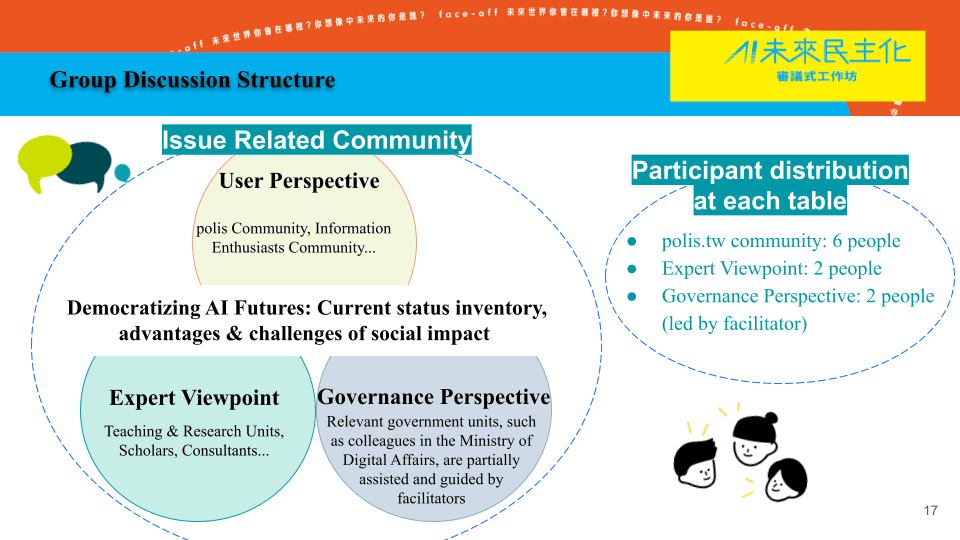
The structure of this group discussion is roughly divided into two major parts. The first round "inventoried the current situation, advantages, and challenges of AI's impact on the society" while the second round focused on "how to use policy tools to promote coexistence between AI and humans." At the deliberation and design level, the first round mainly involves presenting questions and inviting the participants to consider the relationship between themselves and the topic. It is also the warm-up for the topic discussion process, which creates opportunities for mutual understanding and prepares each group to discuss and analyze the assigned topics further. Group sharing is held at the end of each discussion round to allow participants to understand cross-group opinions and construct a more complete imagination of the topic.
During the second round, the facilitator guided the formation of the most basic classification based on public policies according to the views shared across the groups in the morning. The morning session addressed how policy tools can respond to risks and challenges by adopting a top-down public governance and bottom-up citizen participation model. After analyzing and sequencing the conditions, we formulated action plans that are both executable and innovative to usher in a new era of coexistence between humans and AI.
Based on the session's purpose and discussion plan, our team created a tool sheet to help advance the on-site discussion. Participants are asked to share their positive and negative thoughts on AI applications using indicators. The participants of each group can observe each other and understand AI's preferences and application boundaries by reviewing the records and summaries on the record sheet.
Then, we entered the topic discussion phase primarily associated with AI's impact on individual aspects, including advantages and challenges. We used the social structure classification framework to guide participants in sharing perspectives on personal cognition, stakeholder communities, social influence and national governance. The goal is to estimate the different needs and challenges faced by agencies at various levels of society. During this phase, we went beyond the question-asking level by guiding the participants to expand their original thinking framework and imaginations about the issues.
The ultimate goal for the second round of discussions is to propose possible co-creation solutions. After discussing the topic in the morning, each group shared their understanding and the various problems and challenges that must be addressed. Before proposing solutions, we reset our expectations to re-energize the discussion. Although we all know there are many challenges and problems to solve, it is important to consider why humans still aspire to build a future society where AI coexists. What policy tools are currently available to help achieve this ideal? At this level, we categorized policy tools into three major categories: laws/rules, strategies/plans and competition projects. The goal is to assist participants in organizing solutions into specific categories, allowing them to effectively link to the corresponding policy development stage during policy implementation.
Prior to implementation, our team usually conducts internal drills via the facilitator's workshop to establish the design framework and identify issues that can meet the original design vision while meeting the operation units' expectations. Drills also ensure facilitators can implement the framework and connect the issues and practices. The facilitators will guide the participants step by step to share opinions during the on-site discussion. Table records typically include writing keywords from the participants' opinions on N stickers or colored pen drawings, allowing participants to look back and construct their own views through opinion stacking. Finally, the facilitator summarized and organized the opinions to form specific suggestions within the group.
Polis analysis
Before the event's design deadline, Aug. 1, 2023, 403 netizens from the polis.tw poll voted and made 8,591 choices. On average, each voter made over 21 choices and proposed 126 arguments, and a total of 260 people were divided into groups. The following briefly describes the opinions and preferences for generative AI applications expressed in the polis.tw poll:
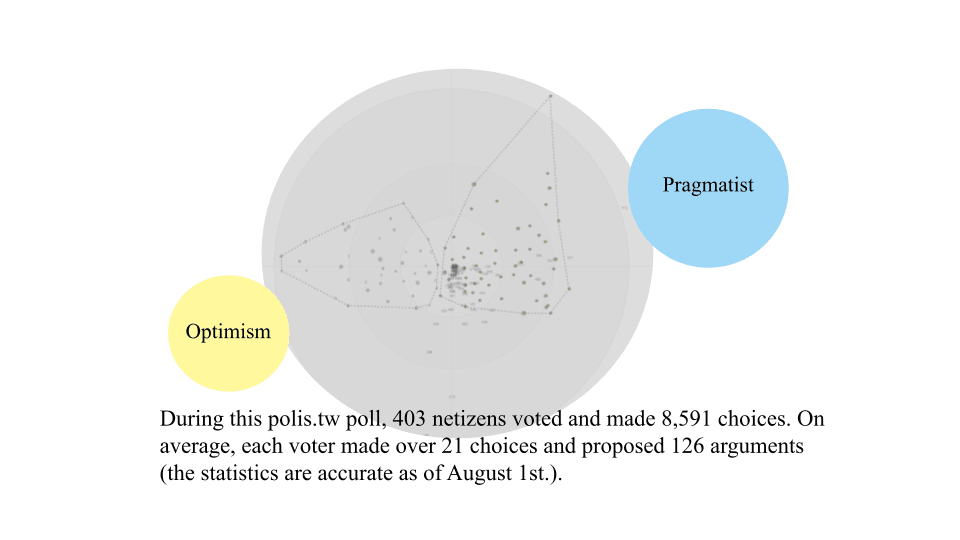
- (I) Analysis of opinions from those with a high degree of consensus In general, netizens' consensus-oriented statements fall into two categories. The first represents a more optimistic view of AI services. They believe AI applications are just tools such as auxiliary or collaborative products, and there is no reason to be concerned. They agree that AI can help humans work more efficiently, but the benefits and drawbacks vary depending on how humans use it. The opposing viewpoint believes that AI has the potential to alter certain social conditions and raises doubts about certain regulatory boundaries.
No. Content Degree of Agreement 118 The referenced sources of AI-generated content should be appropriately labeled. 95 percent agree (N=145) 44 As AI technology advances toward new boundaries, the lines between human and machine-generated creations become increasingly blurred. Key intellectual property rights and legal liability questions must be explored in depth. 94 percent agree (N=155) 54 Public servants must receive relevant training before using AI to handle their duties. 92 percent agree (N=166) 104 We cannot rely solely on AI. Regarding security protection and judgment, human nature must also be considered. This is the biggest difference between humans and AI. 92 percent agree (N=157) 45 The current development status of AI will dramatically alter the ecology of many industries. 91 percent agree (N=155) 48 Regarding AI standards, different cultures and contexts worldwide must be considered rather than just the views of a single country. 88 percent agree (N=171) 55 The use of AI can reduce the burden on national civil servants, but it is critical to consider how to handle confidential information without risk of leakage. 87 percent agree (N=165) - (II) Analysis of opinions from those with a certain degree of consensus The three groups from this report indicated that Group B has relatively neutral opinions, group C is more optimistic about AI tools, and group A pays more attention to human interaction and believes that AI will partially change the current status. After analyzing the opinions of those with a high degree of consensus, we referred to the opinions that all group members agreed with cross-group consensus to confirm the opinions with a high degree of consensus and used them as an important reference for subsequent discussion topic selection. The current observation is based on the degree of consensus, which ranges from high to low but does not deviate from the framework of the preceding analysis. One phenomenon we noticed is that most people who are pleased with the results and those who believe the current situation will be partially changed are not mutually exclusive. Some opinions have also reached cross-group consensus. The opinions with group consensus are listed in the following table:
No. Content Degree of Agreement 44 As AI technology advances toward new boundaries, the lines between human and machine-generated creations become increasingly blurred. Key intellectual property rights and legal liability questions must be explored in depth. 94 percent agree (N=155) 80 Use AI with a positive attitude and learn how to use it effectively together. 94 percent agree (N=169) 85 The application of AI is still in its early phase. There is still much room for deciding whether AI poses an opportunity or a threat. Limiting yourself is unnecessary, but you must prepare for AI in advance. 95 percent agree (N=185) 117 AI is a tool, but ensuring the authenticity of the information provided is the expression of personal professionalism. People who use AI will improve their work efficiency. Similar to the rise of Google, the rise of AI is another change in the thinking model. 100 percent agree (N=27) 45 The current development status of AI will dramatically alter the ecology of many industries. 91 percent agree (N=155) 104 We cannot rely solely on AI. Regarding security protection and judgment, human nature must also be considered. This is the biggest difference between humans and AI. 89 percent agree (N=77) 83 The final judgment regarding AI matters still belongs to humans. 92 percent agree (N=152) 54 Public servants must receive relevant training before using AI to handle their duties. 92% agree (N=155) 106 AI cannot replace all life skills but it can make life more convenient. 94 percent agree (N=37) - (III) Aspects of more divergent opinions In response to the questions with highly divergent answers expressed by the opinion survey participants, such questions may be discussed in the current social context. They also serve as an important reference point for analyzing future planning discussion topics. The questions with divergent answers are listed as follows:
No. Content Degree of Agreement 56 It is trustworthy for the government to use AI to carry out its duties. 36 percent agree; 5 percent disagree (N=48) 47 When AI becomes ubiquitous in the future, the entire world will transition from the post-truth era to the no-truth era, altogether abandoning or unable to pursue the truth. 42 percent agree; 36 percent disagree (N=183) 10 The fear of new technology is exaggerated, and humans do not need to understand how it works to take full advantage of it. 55 percent agree; 34 percent disagree (N=185) 66 Overreliance on AI may deprive students of interpersonal communication opportunities and compromise their social skills. 53 percent agree; 25 percent disagree (N=189) 60 AI destroys and compresses the original data, making it more difficult to obtain accurate data during the learning process. 45 percent agree; 27 percent disagree (N=156) 39 When AI creates something that humans used to make, it becomes more meaningful. 60 percent agree; 20 percent disagree (N=163) 69 I believe the works submitted can be generated by AI and then completed using Photoshop. 66 percent agree; 15 percent disagree (N=178) 6 Copyright costs will become less constrained as the production of large-scale, high-quality derivative works becomes more affordable. 64 percent agree; 22 percent disagree (N=166) 67 I believe there should be a separate award for works generated using AI 66 percent agree; 15 percent disagree (N=48) 64 As educators, we must provide experiences that are more authentic and personal than AI-generated content. 63 percent agree; 13 percent disagree (N=165) - (IV) Suggested discussion topics
According to the preliminary analysis above, the netizens' attitudes toward generative AI can be roughly divided into two major groups based on majority votes. One group is happy with the current results, and the other believes some control is required. When the consensus across the groups is further classified, there is no significant conflict between opinions, and the majority consensus is generally agreed upon across the groups. According to the survey participants, we can tentatively regard a "positive view towards generative AI, but it is necessary to propose control plans for certain industries" as the majority opinion from this survey.
As we delve deeper into the divergent parts, we can identify the issues that cause confusion or doubts among users, such as government governance, including internal applications and regulatory mechanisms, information identification, data openness, intellectual property, education, and human cognitive impacts. These concerns are likely raised by those who support generative AI but believe some regulations are necessary. Since the same group clearly disagreed on choices for the topics listed above, the cause should be investigated further using qualitative data collection.
Based on international trends, the current state of domestic issues and opinions gathered from polis.tw , we recommended the topic discussion workshop to focus on six topics for the discussion topic design. They include government governance, focusing on internal applications; the emerging rule of law, focusing on regulatory mechanisms; information identification; data openness; intellectual property and education; and impacts on human cognition.
Following the preceding analysis, professional facilitators distributed the relevant issues to the people for on-site deliberative workshop discussions.
In a democratic society, representatives are elected by ballots and regular elections using direct or representative democracy mechanisms to exercise public power on behalf of the people. Although the vote aggregation and competitive democratic operation model can achieve the operational effectiveness and decision-making efficiency required for national governance, it is not without flaws. When a majority decision-making system and winner-takes-all approach are in place, minority citizens may struggle to express opinions fully, resulting in what is known as majority violence. To address the challenges of aggregative democracy, contemporary scholars have proposed deliberative democracy, which advocates allowing citizens to participate in public policy discussions and form collective opinions to influence decision-making through public deliberation.
With the rapid development of contemporary society, public issues are becoming more complex and cross-disciplinary. As a result, the people's demand for information disclosure is increasing. Policy planning and promotion require more than just seeking compromise or consensus between the government and society. Instead, it is becoming increasingly important to address the diverse differences between social groups. In today's world, there is a pressing need for a platform that facilitates communication and interaction. This is necessary to encourage more discussions and diverse viewpoints, and to establish new collective opinions or consensus through mutual understanding and observation. Such a concept coincides with the so-called deliberative democracy. Effective social dialogues are crucial for enhancing democratic understanding and improving public discourse.
The design of these two event sessions is titled Deliberative Workshop because it heavily references the spirit of deliberative democracy. We invite citizens to participate in agenda discussions, express opinions, and organize and summarize the suggestions discussed in the public policy planning and design process, which the citizen participation model supplements. Of course, such a time-consuming process cannot be automated solely through meetings due to time constraints. Instead, professional facilitators must lead the discussions to help participants quickly understand public issues and reach conclusions within a limited time frame. By setting sufficiently specific questions, we can achieve our goal of gathering constructive or implementable policy recommendations.
As previously stated, the executive team of CIDS and NCCU has experience discussing numerous issues during deliberation operations and emphasizes the use of perceptual empathy. When promoting deliberative democracy, we believe it is critical to emphasize mutual understanding and openness by listening to the opinions of others to reflect on and broaden the people's perspectives. It is crucial to highlight such experiences as we promote deliberative democracy. The deliberative workshop also included play design elements in which team members performed short plays about the impact of AI on society, allowing participants to imagine possible scenarios and relate them to their own experiences. This enabled subsequent discussions to transcend the theoretical level and be closer to human society's actual operation patterns and needs.
As mentioned above, these two workshop sessions' activity design and on-site operations closely followed the spirit of deliberative democracy. The goal is to replicate the benefits emphasized by the deliberative democracy model. The implementation team conducted research and presented the findings in a simplified and easy-to-read format. We then established the agenda and discussion topics so that participants could speak from multiple perspectives in a limited time. The opinions were then collected and analyzed under the facilitators' leadership. We considered the topic's perceptual inspiration and used play performances to broaden the participants' perceptions. This elevated the discussion to more than just words on paper, making it more relevant to potential situations in human society.
This method of operation has clear advantages. It allows all participants to express opinions within a specified time frame under the guidance of skilled facilitators. Additionally, it enables participants to communicate, reconsider subjective views, and strive for a collective consensus by observing one another. Setting sufficiently specific and clear questions created opportunities to collect constructive and actionable policy recommendations. By actively participating in discussions that foster mutuality, reflection and acceptance, the participants can develop empathy and an accepting attitude toward the on-site recommendations. The positive cycle achieved through deliberation can assist public decision-makers in promoting policies, regardless of whether the issues discussed on-site can return to the decision-making level or are in the policy planning, legalization, or implementation phase.
In contrast, the side effects can be roughly divided into two aspects. The costs of social mobilization for activities such as deliberation and discussion are considerable. For example, only a few people have the time to participate in the entire process. If the quality of the discussion is to be considered, inviting an excessive number of participants to a single event is inappropriate. The usual size of an event is about 20-50 people. Obtaining comprehensive opinions without holding multiple events may be challenging due to the limited number of people who can attend a single event. If a deliberative democracy event has specific social representation requirements, systematic or purposive sampling may be used to invite participants to mitigate the risk of participant composition influencing the opinion collection.
The second side effect is that the meeting's conclusions must be verified. Because of the high cost of managing deliberative democratic activities, both the organizer and the participants typically have high expectations for the implementation and impact of the conclusions. If the discussion concerns policy issues, the relevant conclusions must still be returned to the appropriate administrative agencies for implementation. Only then can we test whether the results discussed on-site are feasible for implementation. Retesting the method discussed may not be possible until the time of implementation. This is most likely because in the deliberative democracy discussion process, no matter how positive the atmosphere is or how remarkable the results are, it is difficult to claim that the meeting's conclusion reached by the collective consensus at the time of the meeting will be effectively implemented during policy design.
To mitigate the abovementioned side effects and risks, when the organizers realize that the topic expected to be discussed is not a general social issue but a contentious issue that may soon become a policy agenda, it is necessary to ensure that the invited participants can express perspectives on the agenda. Meanwhile, facilitators must serve as intermediaries, sort through and summarize the topic materials, and propose agendas with discussion value. The facilitators must also navigate diverse opinions on site, understand the meeting's purpose and develop specific and constructive solutions to facilitate public discussions on the value of deliberative democracy effectively. It is also essential to connect these discussions to policy practices and exert influence to ensure they have a meaningful impact.